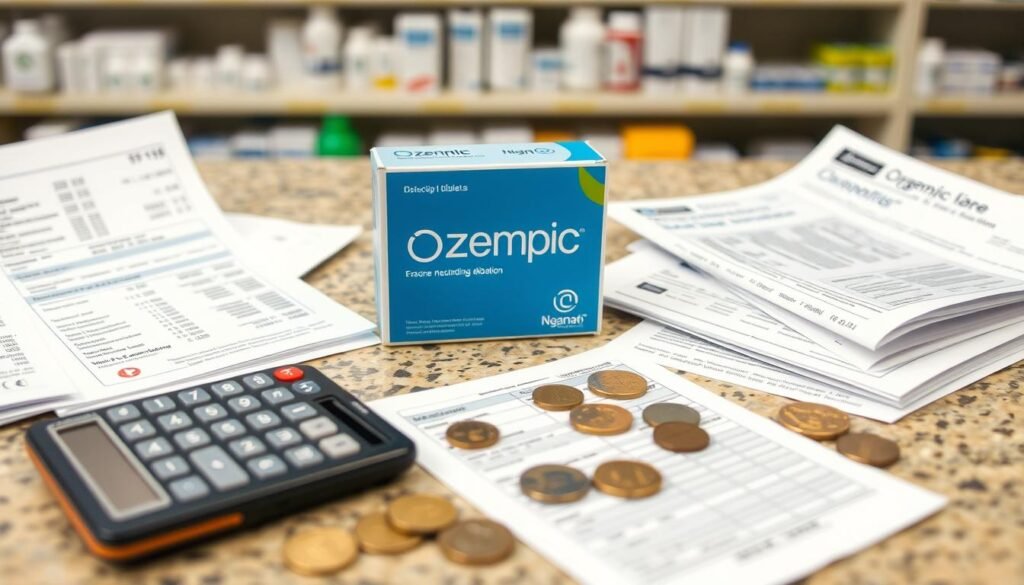Will Insurance Cover Ozempic for Prediabetes?
The answer is that insurance coverage for prediabetes in Ozempic is not guaranteed and varies based on your insurance plan and individual circumstances.
Prediabetes is becoming more common. People and doctors are looking for ways to manage it and stop type 2 diabetes. Ozempic, a drug for type 2 diabetes, is being considered. But, will insurance cover it for prediabetes? This depends on the insurance company.
Ozempic is approved for type 2 diabetes. But using it for prediabetes is not approved. This makes getting insurance harder. This article will explain how insurance works, what it takes to get coverage for off-label drugs, and how to get Ozempic for prediabetes covered.
Table of Contents
ToggleKey Takeaways
- Ozempic’s use for prediabetes is considered an off-label application, which can impact insurance coverage decisions.
- Insurance plans categorize drugs into tiers with different cost-sharing formulas, affecting out-of-pocket costs for medications like Ozempic.
- Insurers may require prior authorization and step therapy, where cheaper treatments must be tried first, for coverage of Ozempic.
- Alternative medications similar to Ozempic may have better insurance coverage or lower costs, providing potential options for prediabetes management.
- Navigating insurance policies and securing coverage for Ozempic can be challenging, but understanding the process and exploring financial assistance options can help.
Understanding Prediabetes and Its Risks
Prediabetes is a serious health condition that can lead to type 2 diabetes. It happens when blood sugar levels are higher than normal but not high enough to be called diabetes. The Centers for Disease Control and Prevention (CDC) says over 88 million American adults have prediabetes. Yet, most don’t know they have it.
What is Prediabetes?
Prediabetes is a warning sign that you might get type 2 diabetes or other health problems. It often shows no symptoms. Doctors find it through blood tests that check fasting glucose or hemoglobin A1c.
Symptoms and Risk Factors of Prediabetes
People with prediabetes might not show any symptoms. But, some may notice darker skin in certain areas. Being overweight, having a family history, and a sedentary lifestyle are big risks.
It’s important to catch prediabetes early. With the right steps, you can stop it from turning into type 2 diabetes. Managing prediabetes well is key to preventing type 2 diabetes.
“Prediabetes serves as a warning sign that an individual is at increased risk for developing diabetes and other related health issues.”
Ozempic: A Potential Solution for Prediabetes Management
Prediabetes is becoming more common. Doctors are looking for new ways to manage it and stop it from turning into type 2 diabetes. Ozempic, a drug mainly for type 2 diabetes, is being considered.
Overview of Ozempic and Its Mechanism of Action
Ozempic, or semaglutide, is an injectable drug. It helps control blood sugar in people with type 2 diabetes. It works like a hormone that helps insulin release when you eat.
This action not only lowers blood sugar but also helps with weight loss. Losing weight is key in managing prediabetes.
Research shows that Ozempic can lead to an average weight loss of around 15%. This makes it a good option for those with prediabetes who are overweight. Even though it’s mainly for type 2 diabetes, doctors are interested in using it for prediabetes too.
Ozempic could help in two ways. It can control insulin and blood sugar, preventing type 2 diabetes. It also helps with weight loss, a big risk factor for the disease.
But, more research is needed to know if Ozempic is safe and effective for prediabetes. Doctors will have to think carefully about its benefits and risks before using it.
Insurance Coverage for Prescription Drugs
Understanding insurance for prescription drugs can be tough. But knowing what affects coverage can help patients get the treatments they need. Drug formularies are key in this process.
How Drug Formularies and Insurance Policies Work
Drug formularies list covered medications. Each drug has a tier based on cost, effectiveness, and FDA approval. Insurers use these lists to decide coverage and copays for drugs like Ozempic.
Where a drug is in the formulary affects costs. Lower-tier drugs have lower copays. Higher-tier drugs cost more.
| Drug Tier | Typical Copay | Examples |
|---|---|---|
| Tier 1 | $0 – $10 | Generic medications |
| Tier 2 | $10 – $35 | Preferred brand-name drugs |
| Tier 3 | $35 – $75 | Non-preferred brand-name drugs |
| Tier 4 | $75 – $150 | Specialty medications |
Knowing your insurance plan’s formulary helps. Patients can make better choices and work with doctors to get the right coverage.
Will insurance cover ozempic for prediabetes?
Whether insurance will cover Ozempic (semaglutide) for prediabetes is a tricky question. Ozempic is approved by the FDA for type 2 diabetes. But, using it for prediabetes is not officially approved. This makes a big difference in insurance coverage.
For prediabetes, doctors usually suggest diet and exercise changes. But, if you’re at high risk for type 2 diabetes, Ozempic might be an option. Insurance will look at if it’s needed and if it’s cheaper than other treatments.
Remember, insurance rules can change a lot between companies. Some might cover Ozempic for prediabetes, while others won’t. Your health, doctor’s reasons, and insurance rules all matter.
To know if your insurance covers Ozempic for prediabetes, check your plan. Talk to your doctor and insurance company. This will help you get the coverage you need.
“Even a 5-10 percent reduction in body weight can lead to improved blood pressure, cholesterol, and blood sugar, according to the CDC.”
Getting Ozempic covered for prediabetes is complex. It depends on your situation and insurance rules. Knowing these details helps you make smart choices and get the right coverage.
Criteria for Coverage of Off-Label Medications
Insurance companies have specific rules for covering medications like Ozempic for conditions like prediabetes. They first check if the medication is really needed for the patient’s health. Doctors must explain why Ozempic is key for managing prediabetes.
Medical Necessity and Evidence-Based Support
Insurance companies need strong proof that Ozempic is needed for prediabetes. They look at studies, medical guidelines, and other trusted sources. These must show Ozempic works well in managing prediabetes and preventing type 2 diabetes.
FDA Approval Status and Off-Label Use Considerations
The FDA’s approval of a medication is very important for insurance coverage. Ozempic is mainly for type 2 diabetes, but for prediabetes, it’s off-label. Insurers are more careful with off-label uses unless there’s clear evidence it’s safe and works well.
Understanding what insurers look for can help patients and doctors get Ozempic covered for prediabetes. It’s a complex issue, but knowing the criteria can make a big difference.
Navigating Insurance Policies and Securing Coverage
Getting insurance for Ozempic for prediabetes needs a smart plan. Start by checking your health insurance policy. Look at the parts about prescription drug coverage and off-label drug rules. Knowing what your plan needs is key.
Reviewing Your Plan’s Prescription Drug Coverage
Get to know your insurance plan’s drug list. This list shows which drugs are covered and what rules they have. It helps you see if Ozempic is covered and what steps you might need to get it.
Communicating with Healthcare Providers and Documentation
Working with your doctors is important for getting Ozempic coverage. They must explain why Ozempic is right for you. This includes talking about your health risks, past treatments, and why Ozempic is a good choice.
By understanding your insurance, checking drug coverage, and talking to your doctors, you can get Ozempic for your prediabetes. This effort can lead to better health and save money too.
“The key to securing insurance coverage for Ozempic in the context of prediabetes is a strategic and informed approach, focusing on understanding your plan’s requirements and collaborating with your healthcare providers to provide the necessary documentation.”
Understanding Prior Authorization Requirements
To get insurance for Ozempic, especially for treating prediabetes, patients and doctors must go through a prior authorization process. This step requires detailed info about the patient’s health, past treatments, and why Ozempic is needed.
The insurance company checks if the medication is really needed and if it’s cheaper than usual treatments for prediabetes. Knowing what the insurance plan needs is key to getting Ozempic approved.
- Many insurance companies need prior approval for Ozempic, especially for treating prediabetes.
- The process asks for detailed info about the patient’s health, past treatments, and why Ozempic is prescribed.
- Insurance companies look at if Ozempic is needed and if it’s cheaper than usual treatments for prediabetes.
- Getting Ozempic approved is important for getting insurance coverage, as providers check the reason for the medication.
Understanding the prior authorization rules is crucial for patients and doctors to get Ozempic covered for prediabetes treatment. Knowing what’s needed can help get approval and access to this important medication.
Appealing Denied Coverage Decisions
If your insurance denies Ozempic coverage, don’t worry. You can appeal the decision. Gather more evidence to make a strong case. This might help you get the coverage you need for your prediabetes treatment.
Gathering Additional Evidence and Support
To appeal a denied coverage, you need a solid evidence package. It should show Ozempic is medically necessary for you. Here’s how to do it:
- Get a detailed letter from your doctor. It should explain why they prescribed Ozempic and how it meets your medical needs.
- Collect important clinical data. This includes your past test results, weight loss efforts, and any other proof Ozempic is right for you.
- Look for support from patient groups or medical organizations. They can offer more information or letters to help your case.
With a strong case, you might win your appeal. This could get you the Ozempic coverage you need.
“49% of healthcare-related denial appeals are successful as of 2021.”
Knowing how to appeal and gathering the right evidence is crucial. It can help you get Ozempic coverage for your prediabetes treatment.
Cost Considerations and Financial Assistance Options
Dealing with Ozempic costs can be tough, even with insurance. The average monthly cost of Ozempic is between $600 to $800. This can be a big burden for those with prediabetes. But, there are ways to make this medication more affordable.
Novo Nordisk, Ozempic’s maker, has a patient help program. They also offer a savings card for those with insurance. This can really help cut down costs.
The price of Ozempic changes based on dosage, insurance, and pharmacy. Getting a 90-day supply or using a mail-order pharmacy can lower costs. It’s key to know about any insurance rules that might affect how much you pay for Ozempic.
| Cost Consideration | Financial Assistance Options |
|---|---|
| Average monthly cost: $600 – $800 |
|
| Retail price: $969 |
|
By learning about costs and looking into help, people with prediabetes can get Ozempic. This can help them manage their condition better.
“Understanding the potential costs and researching available assistance can help make Ozempic more accessible for those who require it as part of their prediabetes management plan.”
Alternative Treatments and Lifestyle Modifications
Ozempic might help with prediabetes, but it’s not the only choice. Prediabetes management often starts with lifestyle changes. This includes better diet and more exercise. Doctors might also suggest alternative medications like metformin to help manage prediabetes and prevent type 2 diabetes.
It’s important for patients to talk with their doctors about all treatment options. They can find the best mix of lifestyle changes and medication for them. This plan should fit their health goals and needs.
Lifestyle Changes for Prediabetes
- Eat a healthy, balanced diet with lots of fruits, veggies, whole grains, and lean proteins.
- Do regular physical activity like brisk walking, swimming, or cycling for 30 minutes a day.
- Keep a healthy body weight with diet and exercise.
- Manage stress with meditation, yoga, or counseling.
- Get sufficient, quality sleep every night.
Alternative Medications for Prediabetes
- Metformin: Helps improve insulin sensitivity and lowers the risk of type 2 diabetes.
- Acarbose: Slows down carbohydrate absorption and lowers blood sugar.
- Pioglitazone: Improves insulin sensitivity and reduces type 2 diabetes risk.
Looking into different alternative prediabetes treatments and lifestyle changes for prediabetes helps. People can work with their doctors to make a plan that meets their health needs and goals.
“The key to managing prediabetes is a comprehensive approach that combines lifestyle modifications and targeted medical interventions, tailored to the individual’s needs and preferences.”
Conclusion
Insurance coverage for Ozempic for prediabetes is complex. Ozempic helps manage type 2 diabetes well. But, using it for prediabetes can be tough to get covered.
Patients and doctors must work together. They need to understand insurance rules and get Ozempic approved. This is key for managing prediabetes.
Knowing how to talk to insurers can help. This way, people might get to use Ozempic. It’s part of a big plan to stop type 2 diabetes.
This article has covered important points. It shows how to deal with insurance and get Ozempic. It’s all about making sure people with prediabetes get the help they need.
Getting Ozempic for prediabetes is not easy. But, it could really help. Everyone needs to work together. This includes patients, doctors, and insurance companies.











